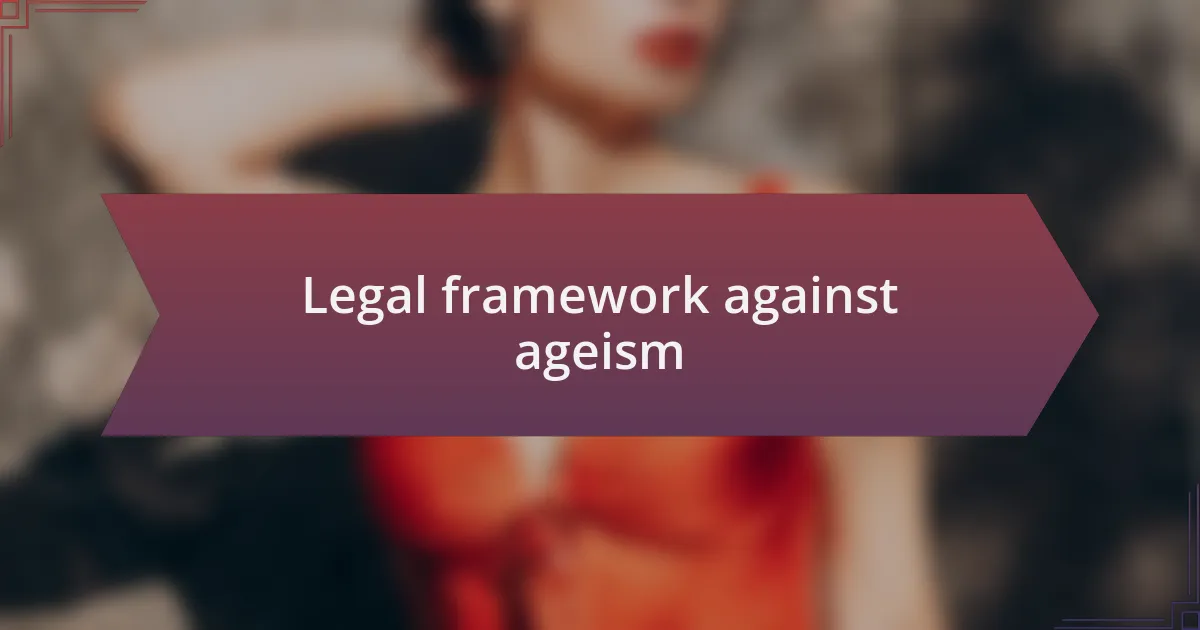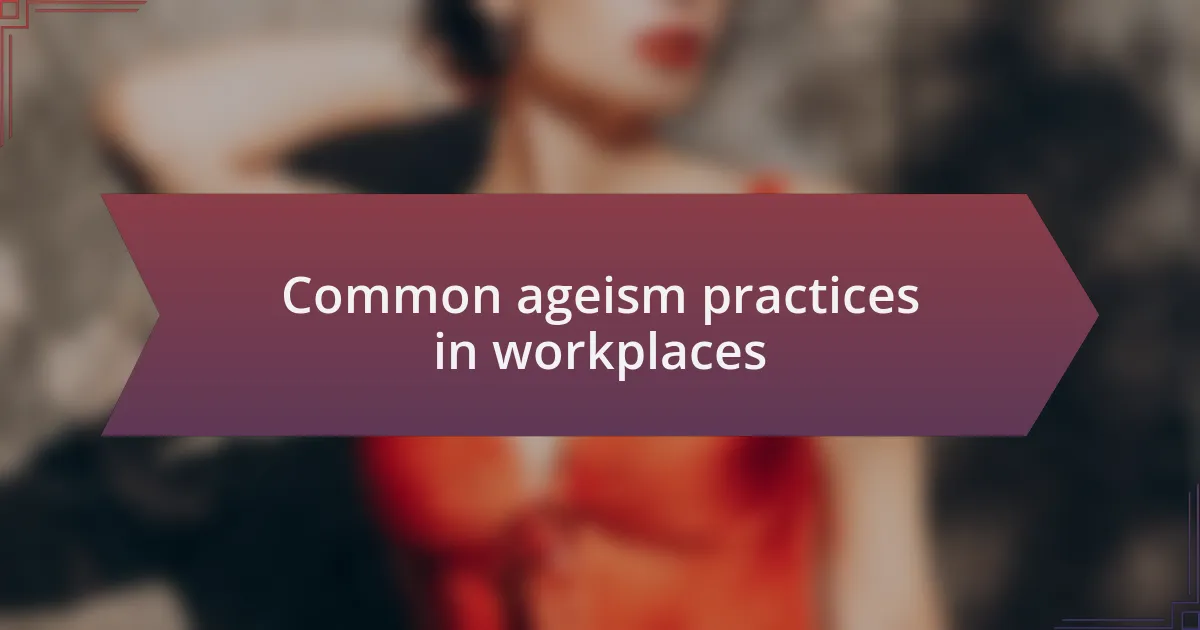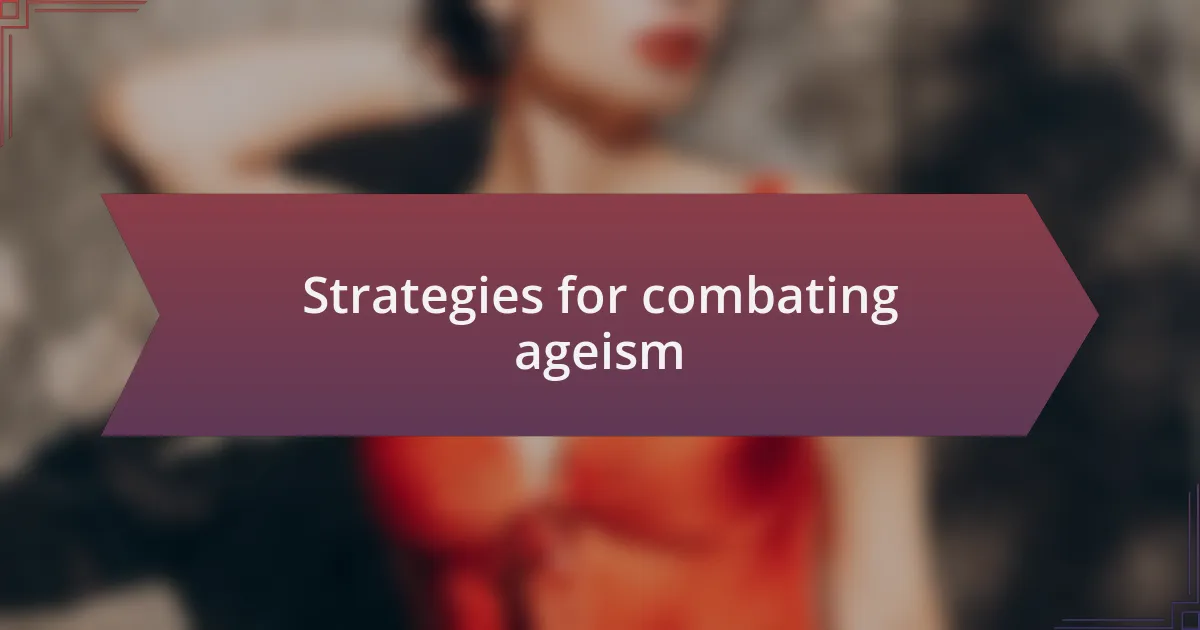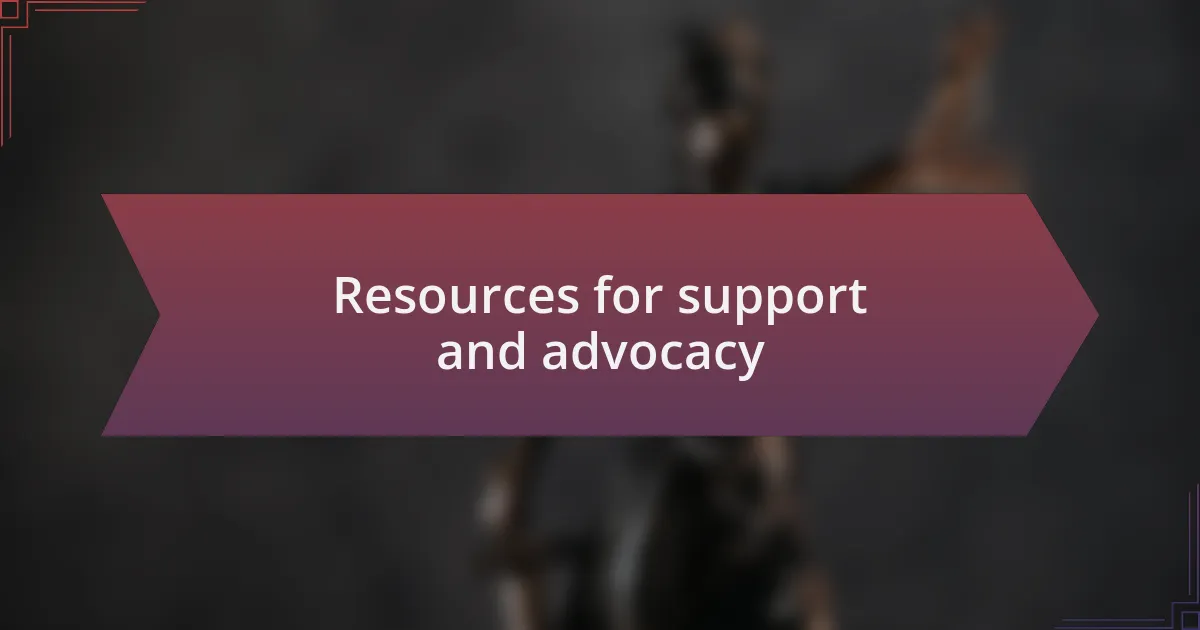Key takeaways:
- Ageism in employment can lead to talented individuals being overlooked due to biases against older workers, affecting career opportunities and workplace culture.
- The Age Discrimination in Employment Act (ADEA) provides a legal framework against ageism, but practical enforcement and the gathering of evidence can be challenging for affected workers.
- Creating effective policies, such as mentorship programs and inclusive job descriptions, can foster intergenerational collaboration and challenge ageist norms in the workplace.
- Accessing resources and connecting with advocacy groups can empower individuals facing age discrimination and promote awareness and support for age diversity.

Understanding ageism in employment
Ageism in employment is often a silent issue, manifesting in subtle ways that can significantly impact one’s career trajectory. I’ve seen colleagues dismissed for their age, rather than their capabilities, which raises a troubling question: how many talented individuals are overlooked simply because they have a few more years under their belt? This bias can lead to feelings of invisibility, as if the experience and wisdom gained over a lifetime are somehow less valuable.
In my own experience, I remember being in a meeting where younger team members were favored for leading projects, despite my years of relevant experience. It felt disheartening to watch fresh perspectives be prioritized over established knowledge. This scenario highlights a common misconception: that youth equates to innovation, while age is mistakenly viewed as a barrier to adaptability.
Moreover, ageism isn’t only about hiring practices; it seeps into workplace culture and dynamics. I often found myself questioning whether my ideas were dismissed due to bias against my age or simply lack of interest from my peers. It’s an introspective journey, one that forces us to confront the stereotypes that persist in our professional environments and consider how they affect everyone involved.

Legal framework against ageism
Addressing ageism requires a solid legal framework designed to protect workers of all ages. The Age Discrimination in Employment Act (ADEA), enacted in 1967, is a cornerstone of this framework in the U.S., prohibiting discrimination against individuals aged 40 and older. I often wonder how durable these protections are in practical settings—do they truly empower older workers, or are they just a safety net on paper?
In my observation, state laws can supplement federal regulations, providing additional protections tailored to local workforces. For instance, some states have adopted laws that prohibit age discrimination for individuals younger than 40, expanding the interpretation of what ageism can look like in the workplace. It makes me think: how crucial is it for workers to be aware of these nuances in the law?
Moreover, I find it compelling that legal action against ageism often requires clear evidence of bias. This means that workers must gather proof of discrimination, which can be daunting and emotionally taxing. I remember speaking with a colleague who faced significant challenges building a case based solely on anecdotal experiences, emphasizing the need for better support systems for individuals navigating these legal waters. How can we expect those affected by ageism to fight against it if the path is so complicated?

Common ageism practices in workplaces
Common ageism practices in workplaces manifest in various insidious ways. One prevalent practice I’ve noticed is the stereotyping of older workers as being resistant to change, particularly with technology. This mistaken belief not only undermines their skills but also often leads to exclusion from training opportunities. It stings to see intelligent and capable colleagues overlooked simply because of their age, leaving me wondering how many valuable perspectives are lost due to such biases.
Another common issue is the tendency to prefer younger employees for hiring or promotions under the assumption that they are more dynamic. I recall a time when a friend, highly experienced and with a proven track record, was passed over for a promotion in favor of a younger candidate whose qualifications were equivalent. It raises a larger question: how can companies truly benefit from diverse viewpoints if they perpetuate a culture that prioritizes youth over experience?
Additionally, I’ve experienced the discomfort of workplaces where social activities tend to cater exclusively to younger employees. This exclusion can create an atmosphere where older workers feel invisible or even alienated. I can’t help but think about how these subtle practices contribute to a divide that ultimately harms team cohesion and affects productivity. Isn’t it time we recognize the value of all ages in fostering a richer workplace culture?

Addressing ageism through policies
Creating effective policies to address ageism in the workplace is not only essential but also surprisingly impactful. I remember when my company implemented a mentoring program that paired older employees with younger ones. This initiative not only fostered knowledge exchange but also dispelled myths about older workers being resistant to new ideas. It showed me that when organizations actively promote intergenerational collaboration, they can cultivate a more inclusive environment.
Moreover, explicit anti-ageism policies are crucial in the hiring process. I once reviewed a job description that explicitly stated a commitment to diversity, including age diversity, which really stood out to me. This simple inclusion shifted how candidates perceived the company, making it clear that all backgrounds were valued. I’ve seen firsthand how adopting such policies can expand the talent pool and bring in a wealth of experience that might otherwise be overlooked.
One vital aspect is the regular training of managers to combat age bias. In my experience, I’ve attended workshops that addressed unconscious biases, and it was eye-opening. These sessions not only raised awareness among peers but also challenged us to reflect on our own attitudes towards age. I often wonder: how many leaders in organizations are unaware of the sway their biases can have on team dynamics? Establishing ongoing education is key to creating a durable culture that values every age group.

Personal experiences with ageism
Throughout my career, I’ve encountered ageism firsthand. I vividly recall a project meeting where a younger colleague dismissed my ideas, attributing them to my age rather than their merit. It left me frustrated and questioning whether my experience was truly valued. Have you ever felt that sting? It’s a tough moment when the years you’ve spent gaining knowledge seem to be overshadowed by a simple stereotype.
There was a time when I applied for a leadership role that I felt confident about, yet I sensed hesitation from the hiring committee. They never said it outright, but during our conversation, the focus seemed to be on my perceived ability to ‘keep up with the fast-paced digital world’. This left me feeling diminished, as if my years of experience were less relevant than my familiarity with new technology. It begs the question: how often do we let age cloud our judgment about someone’s capabilities?
Another instance that stands out to me was during a company-wide training session aimed at fostering inclusivity. I shared my experiences about navigating challenges that arise due to age stereotypes, and some colleagues approached me afterward, expressing surprise at the depth of what I had to offer. Their reactions reminded me that conversations about age can break down barriers and encourage understanding—if only we are willing to engage openly. What if we all made an effort to share our stories? Wouldn’t that create a more empathetic environment?

Strategies for combating ageism
Tackling ageism often starts with open dialogue. In one of my previous roles, I initiated a regular “experience exchange” meeting, inviting everyone to share their insights without regard to age. The result? It shattered some preconceived notions and built a mutual respect for the different perspectives that we all brought to the table. Have you ever thought about how much we can learn simply by listening to one another?
Creating mentorship programs can also be a game-changer. I remember one company where seasoned employees mentored younger staff through a formal process. This dynamic fostered not only skill transfer but also respect across generations. Imagine the wisdom gained when both sides commit to learning from each other. Wouldn’t that enrich the workplace culture?
Lastly, I’ve seen the impact of positive language in job descriptions and workplace policies. When a previous company refined their language to be more inclusive, it attracted a diverse age range of applicants, challenging the ageist norms in their hiring process. It made me reflect: how often do we let our language shape our bias? Sometimes a simple tweak can open doors to opportunities for everyone, regardless of age.

Resources for support and advocacy
Accessing the right resources can amplify our efforts in combating ageism. For instance, I found incredible value in organizations like AARP and the Job Accommodation Network. They offer a wealth of information on age-related employment issues, providing everything from legal guidance to career development resources. Have you ever sought help from a community resource that made a significant difference in your perspective?
Additionally, connecting with local advocacy groups can make a huge impact. These organizations often organize workshops and events that raise awareness about age discrimination in the workplace. I participated in a panel discussion once, sharing my experiences and hearing others’ stories. It was a powerful reminder that we’re not alone, and collective voices can break down barriers. Have you considered joining such a group to share your experiences and learn from others?
Online platforms, such as LinkedIn groups focused on age inclusivity, also serve as great forums for support. Engaging with peers and industry leaders there has not only expanded my professional network but has provided me with insights into best practices for addressing ageism. Have you explored these digital avenues to find support and foster conversations around age diversity? Leveraging these resources can really shift perspectives and cultivate a more inclusive environment.